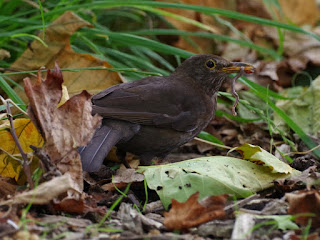The Common Tern is still on the Round Pond, circling the edge with easy grace and looking down for a fish.
It saw one, plummeted into the water and emerged dripping.
Terns don't have waterproof feathers, and their dives last barely a second.
It's said that Cormorants are not waterproof either, and this is why they have to dry their wings after a dive. But actually it is only the outermost layer of feathers that gets wet, which helps to streamline them when they are under water. During a shower, this Cormorant went under the trees on the Serpentine island to dry its wings.
Grebes have a different strategy. Their feathers are waterproof throughout, and they flatten them before diving, which both streamlines the bird and decreases its buoyancy. Diving ducks, which can't do this, have to paddle quite hard to stay submerged.
There was a pair of Red-Crested Pochards on the Round Pond, with the drake going into eclipse but still colourful.
The Black Swan was preening on the Serpentine near the Diana fountain.
One of the Little owlets near the Albert Memorial was easy to find because it was calling.
The owlets from the chestnut tree were audible but invisible in the ash tree in the leaf yard behind the upper bench. But their mother was on her usual branch in the chestnut next to the nest tree.
Four young Blackbirds were following their mother on the patch of wood chips under the plane trees between the Albert Memorial and Physical Energy. They were calling to be fed, but they also seemed to be foraging efficiently among the dead leaves. Their mother clearly thought they could fend for themselves, When she caught a worm she ate it herself.
A young Wren from the colony near the Italian Garden came out on a twig.
A man was throwing bits of bread into the stream in the Dell (it requires considerable strength to get a piece of bread to travel the distance). This greatly excited the carp, which went into a real feeding frenzy.
A Buff-Tailed Bumblebee was collecting nectar in a patch of purple flowers.
I'm not good at wildflowers and thought it was scabious, also called devilsbit, but Cathy tells me it's Common or Lesser Knapweed, Centaurea nigra.
There is a fine crop of Shaggy Parasols in the shrubbery at the southwest corner of the bridge. While we're on the topic of scientific names, this is Macrolepiota rhacodes.












I grow that purple wildflower in my garden. I think it is Centaurea nigra (Common or lesser knapweed). Scabious (Knautia arvensis) looks more like a pincushion and less like a thistle. It's a lovely photo.
ReplyDeleteMany thanks for the information. Have put a note on the blog.
DeleteGreat photos of the Common Tern fishing - they move so fast I am surprised you got it so pin sharp. Another great photo.
ReplyDeleteThanks for your kind words. You should have seen the hundred-odd pictures I discarded.
DeleteI was down south today- Ravensbury Park & the River Wandle, Morden. They've put notices up warning people not to feed bread to water birds. I'm not sure if I've seen that in HP/KG ? Whether it's effective or not, who knows. But the Wandle did seem clear of bread detritus. Mind you, it's a flowing river.
ReplyDeleteThere are small, unobtrusive notices on the Round Pond, but not on the Serpentine or Long Water. Park visitors pay no heed to notices anyway. Probably the people who know about the Wandle are a bit more careful. I stop people from feeding bread to young Egyptian Geese, since this is likely to give them angel wing, but can't stop everyone. The other birds seem to survive on this unhealthy food.
Delete